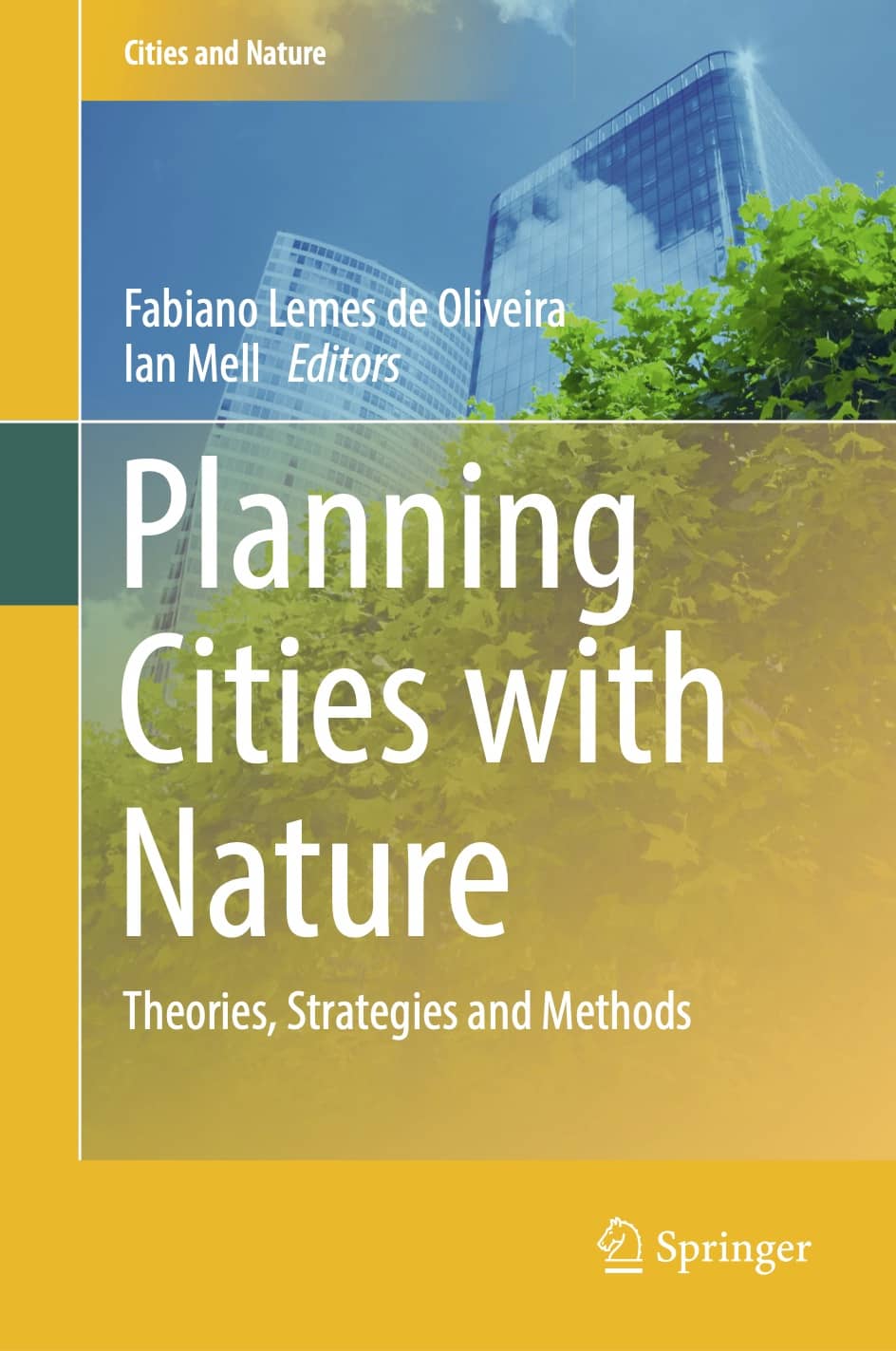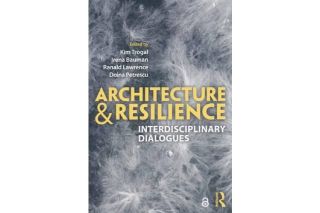
www.buildingsandcities.org/insights/reviews/planning-cities-with-nature-review.html
Planning Cities with Nature
Edited by Fabiano Lemes de Oliveira & Ian Mell. 2019, Springer, ISBN: 9783030018665

Green infrastructure has become one of the most common topics in contemporary environmental urbanism. Yet most urban planning still gives roads, buildings, and engineered infrastructure pride of place in the spatial planning process. This book espouses an alternative approach to planning cities. Rather than leading with the familiar concern with where to put bricks, mortar, concrete, and asphalt, editors de Oliveira and Mell have assembled a collection of nineteen chapters that show what might be gained by planning cities with nature as a more central component. Such "planning cities with nature" goes beyond the classic dichotomy between city and nature, advocating for planning cities as true mixtures of natural and constructed elements for the benefit and wellbeing of residents.
Green infrastructure, the main tool for accomplishing the better integration of the built and the biological in urban places, is a broad palate of interventions. It includes greenbelts, large parks, wetlands, and extensive streamside vegetation. But it also includes some kinds of campuses, public squares, vegetation cover of residential parcels and rights of way, private gardens, and yards. Although green walls and green roofs are considered in some chapters, most of the attention is given to green infrastructure rooted in earth, recognizing the many forms and scales of such green, blue, and combined blue-green or "turquoise" infrastructure. Most examples come from Brazil and the UK, though there is discussion of cases from India, China, and Finland, for example. The book succeeds in giving voice to the green infrastructure concerns of the Global South.
The book is aimed at academics primarily, although the scope of disciplines is broad. The richness of perspectives is informative, but the mixture of professional languages and jargons can make for difficult reading in some cases. History and current reality are in dialogue in many chapters. Practitioners and policy makers are among the authors of individual chapters, so their perspectives do appear. However, the book will be most useful to students and educators who wish to advance training about, and advocacy of, green planning rubrics. This book would be a very useful source in urban planning and urban design studios, both for the variety of frameworks it presents, and for the number of cases discussed in detail. The book can also alert planners in cities and regions of rich new ways to think about and integrate green spaces and functions in their work. However, this is not a "how to" book; rather it is deals more with "why to" and "what to," supported by diverse disciplinary perspectives and the successes and constraints of greening plans and case studies from many ecological, social, and political situations.
The book is a very useful summary of current thinking and examples of the changing role of green infrastructure in cities. Although the chapters are all planning or design oriented, each reflects a different approach to green infrastructure. No discipline dominates the discussion. Rather, readers are exposed to contrasting views of this complex topic. Readers will benefit from diverse perspectives across the chapters. Important contrasts include, for example:
- Marxist economics versus free market payment for services
- Idealized spatial forms of green elements in cities versus the patterns emerging from political compromises
- Prioritizing social equity and "rights to green" versus economic development
- Different national and regional legal frameworks, e.g. in Brazil and in Finland.
Such contrasting motivations show just how inclusive the thinking on green infrastructure must be.
Yet, individual motivations of green infrastructure are also explored in depth. For example, the classic forms of green wedges and green rings inform much thinking about green infrastructure networks, and these forms are usefully compared and contrasted with built urban forms, such as grid, linear, concentric, and radial. Surprisingly, although these green forms were presented as powerful universals, they only appear to scaffold a few of the later chapters.
Additional motivations among the chapters include the philosophical and cultural differences that characterize different cases. This richness of thought will be helpful for researchers as they plan or interpret data on green infrastructure. Some of the many examples include how Chinese and Western environmental and cultural philosophy are associated with different motivations for urban greening, although neither is a guarantee of sustainability. Another intriguing motivation is a Brazilian artistic idea of the "no-stop city" which promotes an integrated and flexible view unifying city and countryside, interestingly related to hybrid provision of agricultural and economic production. A radical Viennese artistic movement is used to further illustrate the natural-built hybridity that green planning requires, rather than Modernist separation of nature and urbanity. This impulse toward hybridity does not always succeed, but it is a useful filter for signaling the shortcomings of past approaches to city design and planning that have led to the need to "renature" cities - to use a term common throughout the book.
Not only are diverse motivations presented, but it is clear that motivations for green infrastructure shift through time. One cogent example is how green space as a part of Brazilian university campuses has changed through time. This history shows the integration of changing drivers, such as spatial constraints as Brazil increasingly urbanizes, an evolving educational philosophy, and growing concerns for social equity. High level legal and policy motivations also appear in some of the cases. For example, the changing legal framework for planning in Brazil was used to illustrate shifts in the locus of authority in planning as well as shifts in style away from Modernist separation of functions and forms.
This book promotes a post-modernist, multi-functional approach to planning in general, and to green infrastructure in particular. Planning in many instances still operates as an exercise in separating big blocks of pure kinds of territory across an urban area. Green infrastructure planning that follows ecological principles - meaning both technical and value statements -- and which puts people first in a framework of "People, Policy, Options, and Scale", require a much more nuanced, green/gray/blue approach to integrated urban design. The planning with nature framework requires use of both fine and coarse scale relationships.
An important theme in the book is difference or diversity. The first dimension of difference is that green infrastructure itself is a very heterogeneous category, based on intended function and designed structure. The second dimension is that the locations - in social, ethical, technological, and ecological senses - of green infrastructure installations and networks are also heterogeneous. The book explores the complexity at this intersection of heterogeneities, and provides scholars, students, and practitioners with examples of how the intersections have been or can be addressed.
This book is emphasizes several key themes across the richness of its disciplinary and national viewpoints. Many chapters emphasize social values in their framings. Social equity is a normative guide in many chapters, although it is necessarily expressed differently in different cases because social hierarchies are shaped by different distinctions - race, color, caste, wealth, national origin, etc., in various countries.
The book is a mix of the empirical, philosophical, and theoretical. Some chapters are nicely supported by data on benefits of green infrastructure. Others are more assertions of the value and need for green infrastructure. The book, like the field of green infrastructure more broadly, espouses many definitions. And like this field at large, some of the definitions are vague, leading to the statement that "green infrastructure has not yet stabilised as a concept" (p. 200). The range of definitions emphasize commonly articulated values and characteristics of green infrastructure: multifunctionality, positive human benefits, networked structure, and continued investment through time. Perhaps more attention could have been paid to the negatives that sometimes attend green infrastructure, such as tree senescence and mortality, vegetation maintenance, leaf litter and trash removal, and repair of constructed components. In addition, disempowered social groups or residents may have legitimate concerns with gentrification that can follow neighborhood greening. There is a tendency to neglect the likelihood that any green infrastructure installation or network will have social or economic costs that may not be equally borne by all social groups. Still, placing green infrastructure as functional networks at a more central position in planning, as this book recommends, can have very positive effects on new and renatured cities.
Readers should be aware that copyediting in this volume is uneven, and there are cases where typos completely obscure the meaning of a few sentences. There are also complex, unclear, and badly cast sentences that appear all too frequently through the volume. Readers may be required to do a little grammatical archeology in places. Such lapses should not appear in a book priced at €156.
Latest Peer-Reviewed Journal Content
Net zero retrofit of the building stock [editorial]
D Godoy-Shimizu & P Steadman
Co-learning in living labs: nurturing civic agency and resilience
A Belfield
The importance of multi-roles and code-switching in living labs
H Noller & A Tarik
Researchers’ shifting roles in living labs for knowledge co-production
C-C Dobre & G Faldi
Increasing civic resilience in urban living labs: city authorities’ roles
E Alatalo, M Laine & M Kyrönviita
Co-curation as civic practice in community engagement
Z Li, M Sunikka-Blank, R Purohit & F Samuel
Preserving buildings: emission reductions from circular economy strategies in Austria
N Alaux, V Kulmer, J Vogel & A Passer
Urban living labs: relationality between institutions and local circularity
P Palo, M Adelfio, J Lundin & E Brandão
Living labs: epistemic modelling, temporariness and land value
J Clossick, T Khonsari & U Steven
Co-creating interventions to prevent mosquito-borne disease transmission in hospitals
O Sloan Wood, E Lupenza, D M Agnello, J B Knudsen, M Msellem, K L Schiøler & F Saleh
Circularity at the neighbourhood scale: co-creative living lab lessons
J Honsa, A Versele, T Van de Kerckhove & C Piccardo
Positive energy districts and energy communities: how living labs create value
E Malakhatka, O Shafqat, A Sandoff & L Thuvander
Built environment governance and professionalism: the end of laissez-faire (again)
S Foxell
Co-creating justice in housing energy transitions through energy living labs
D Ricci, C Leiwakabessy, S van Wieringen, P de Koning & T Konstantinou
HVAC characterisation of existing Canadian buildings for decarbonisation retrofit identification
J Adebisi & J J McArthur
Simulation and the building performance gap [editorial]
M Donn
Developing criteria for effective building-sector commitments in nationally determined contributions
P Graham, K McFarlane & M Taheri
Reimagining circularity: actions for optimising the use of existing buildings
R Lundgren, R Kyrö, S Toivonen & L Tähtinen
Effective interdisciplinary stakeholder engagement in net zero building design
S Vakeva-Baird, F Tahmasebi, JJ Williams & D Mumovic
Metrics for building component disassembly potential: a practical framework
H Järvelä, A Lehto, T Pirilä & M Kuittinen
The unfitness of dwellings: why spatial and conceptual boundaries matter
E Nisonen, D Milián Bernal & S Pelsmakers
Environmental variables and air quality: implications for planning and public health
H Itzhak-Ben-Shalom, T Saroglou, V Multanen, A Vanunu, A Karnieli, D Katoshevski, N Davidovitch & I A Meir
Exploring diverse drivers behind hybrid heating solutions
S Kilpeläinen, S Pelsmakers, R Castaño-Rosa & M-S Miettinen
Urban rooms and the expanded ecology of urban living labs
E Akbil & C Butterworth
Living with extreme heat: perceptions and experiences
L King & C Demski
A systemic decision-making model for energy retrofits
C Schünemann, M Dshemuchadse & S Scherbaum
Modelling site-specific outdoor temperature for buildings in urban environments
K Cebrat, J Narożny, M Baborska-Narożny & M Smektała
Understanding shading through home-use experience, measurement and modelling
M Baborska-Narożny, K Bandurski, & M Grudzińska
Building performance simulation for sensemaking in architectural pedagogy
M Bohm
Beyond the building: governance challenges in social housing retrofit
H Charles
Heat stress in social housing districts: tree cover–built form interaction
C Lopez-Ordoñez, E Garcia-Nevado, H Coch & M Morganti
An observational analysis of shade-related pedestrian activity
M Levenson, D Pearlmutter & O Aleksandrowicz
Learning to sail a building: a people-first approach to retrofit
B Bordass, R Pender, K Steele & A Graham
Market transformations: gas conversion as a blueprint for net zero retrofit
A Gillich
Resistance against zero-emission neighbourhood infrastructuring: key lessons from Norway
T Berker & R Woods
Megatrends and weak signals shaping future real estate
S Toivonen
A strategic niche management framework to scale deep energy retrofits
T H King & M Jemtrud
Generative AI: reconfiguring supervision and doctoral research
P Boyd & D Harding
Exploring interactions between shading and view using visual difference prediction
S Wasilewski & M Andersen
How urban green infrastructure contributes to carbon neutrality [briefing note]
R Hautamäki, L Kulmala, M Ariluoma & L Järvi
Implementing and operating net zero buildings in South Africa
R Terblanche, C May & J Steward
Quantifying inter-dwelling air exchanges during fan pressurisation tests
D Glew, F Thomas, D Miles-Shenton & J Parker
Western Asian and Northern African residential building stocks: archetype analysis
S Akin, A Eghbali, C Nwagwu & E Hertwich
Join Our Community

The most important part of any journal is our people – readers, authors, reviewers, editorial board members and editors. You are cordially invited to join our community by joining our mailing list. We send out occasional emails about the journal – calls for papers, special issues, events and more.
We will not share your email with third parties. Read more



Latest Commentaries
Building-Related Research: New Context, New Challenges
Raymond J. Cole (University of British Columbia) reflects on the key challenges raised in the 34 commissioned essays for Buildings & Cities 5th anniversary. Not only are key research issues identified, but the consequences of changing contexts for conducting research and tailoring its influence on society are highlighted as key areas of action.
Lessons from Disaster Recovery: Build Better Before
Mary C. Comerio (University of California, Berkeley) explains why disaster recovery must begin well before a disaster occurs. The goal is to reduce the potential for damage beforehand by making housing delivery (e.g. capabilities and the physical, technical and institutional infrastructures) both more resilient and more capable of building back after disasters.